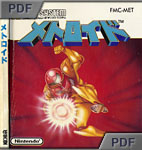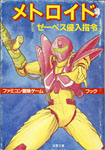|

|

|
|
メトロイド
©1986 Nintendo
Release: 1986-08-06 (¥2600)
DiskCard FMC-MET
Action / platform game


|

Released in America
on cartridge as METROID
(NES-MT-USA) & (NES-MT-USA-1)
|


|

Released in Europe
on cartridge as METROID
(NES-MT-XXX)
|
|
Metroid is an action/platform game and is the first installment of Nintendo's
classic and Alien-influenced series. In a distant future, Space Pirates wreak
havoc to the galaxy, relentlessly attacking ships from the Galactic Federation.
Unable to prevent the attacks, the Federation decides to gather bounty hunters
(called 'Space Hunters' in this version) to counter the threat. But now space pirates
have attacked a research facility and stolen an unknown life-form (that the scientist named
'Metroid') recently found on planet SR388 before it could be safely brought back
to Earth. The federation must now send a space hunter to infiltrate the pirate headquarters
hidden on planet Zebes and stop them before they turn the Metroids into deadly
weapons. The bounty hunter Samus Aran, the female protagonist of the game, accepts
the mission and she has now to travel deep inside the enemy underground fortress, through five
vast areas built around complex networks of caves and rooms. Her primary task is to defeat
the space pirates and all the aliens she faces, up to the toughest of them all - the
monstrous Mother Brain. Although Samus can jump and fire a simple Arm Cannon,
the first upgrade she collects is the Maru Mari, most commonly
known as the Metroid trademark morph ball, which gives her the incredible ability to roll
into a ball and to
rush through narrow corridors and tunnels. But the morph ball is only the tip of the
iceberg and countless other weapons and abilities are available for the taking later in the
game, such as missiles, morph ball bombs, ice beam, wave beam, high jump boots,
increased defense, energy tanks (which increase her maximum life) and so forth.
Zebes is incredibly
vast but unlike other games in the series, this first episode of Metroid doesn't
feature a map (dedicated players had to draw their own). Finally, the Famicom Disk
version includes a three slots savegame system.
|
|
Metroid was only released on disk in Japan (unlike the rest of the world
where is was released in cartridge format). The greatest difference between the
two versions is the saving option. Instead of writing down a password, Japanese
players could save their progress in one of the three available save slots on the
disk. Another interesting element present in this version (and never included in
the cartridge game) are the creepy sound effects that some of the
Metroids do. Thanks to the improved sound chip integrated with the
Famicom Disk System, some of them sound much more organic than the
electronic 'beeps' from the cartridge version.
|
Teaser text from the American version (grey version):
It's you against the
evil Mother Brain in
the thrilling battle of
Metroid!
You're inside the fortress planet
Zebes. The planet of endless secret
passageways where the Metroid are
multiplying. Left alone the Metroid
are harmless. But in the wrong hands they could destroy the galaxy. It's up to
you to prevent the Mother Brain that controls Zebes from using the Metroid
for evil purposes. But that won't be easy. You'll have to use of power items like the
Ice Beam, Wave Beam, High Jump Boots and Varia. If you survive, it will be
you and your acquired powers against the Mother Brain.
|
Teaser text from the American version (yellow version):
It's you against the evil Mother Brain
in a thrilling battle!
More than a million courageous players have
joined Samus Aran in the desperate fight
against the alien Metroids. The demand for
further adventures resulted in a hit Game Boy
title. Now the original is back... and so is the
Metroid menace!
You're inside the planet Zebes, a fortress
of endless passageways where the
Metroids are multiplying. Left alone, Metroids
are merely dangerous, but in the wrong hands
they could destroy the galaxy! Unfortunately,
the Space Pirates who control Zebes have set
up the Mother Brain for just that purpose. It's
up to you to thwart their plans, but that won't
be easy. You'll have to search out and gain use
of power items like the Ice Beam, Wave Beam,
High Jump Boots and Varia. If you survive, it
will be you and your asquired powers against
the Mother Brain.
|
Game Staff (Copied from the American version end credits) :
|
Scenario Written by
Kanoh
Character Designed by
Kiyotake
New Matsuoka
Shikamoto
Music By
Hip Tanaka
Main Programmers
Hai Yukami
Zaru Sobajima
GPZ Sengoku
N. Shiotani
M. Houdai
|
|
Special Thanks to
Ken Zuri
Sumi
Inusama
Kacho
Hyakkan
Goyake
Harada
Penpen
Converted by
T. Narihiro
Assisted by
Makoto Kanoh
|
|
Directed by
Yamamoto
Chief Director
Satoru Okada
Produced by
Gunpei Yokoi
Copyright
1986
Nintendo
|
|
|
G
O
O
D
I
E
S
|
|

Japanese GuideBook
|

Japanese GuideBook
|

Japanese GuideBook
|

Japanese Adventure Book
|
|

Japanese Comic
|
|
|
O
M
A
K
E
|
|




|
|
|
Click on picture to enlarge |
|
|
|
LK

|
|
Add your Pov here !
|
P
O
V
s
|
|
Metroid has become a video game icon and, let's face it, it totally
deserves the honor. Gunpei Yokoi was the creative force behind the
game and Metroid is a great achievement indeed. This is one of those
games that managed to craft a brilliantly atmospheric world with a flawless
gameplay at its core. To me, the non-linear exploration and the uncontrollable
drive to find all the items and power-ups hidden within the game are really what
fuel the adventure. Unfortunately, I played the first Metroid years and years
after finishing Super Metroid for the Super Famicom - and yet, it was
sort of a nice way to be introduced to the series, planet Zebes already
looked familiar to me and I could fill the gaps of the Famicom version.
All in all, Metroid is a true classic and, even to this day, decades after
its original release, I still enjoy running around Zebes's
intricate underground maze.
A timeless masterpiece.
|
|
|
|